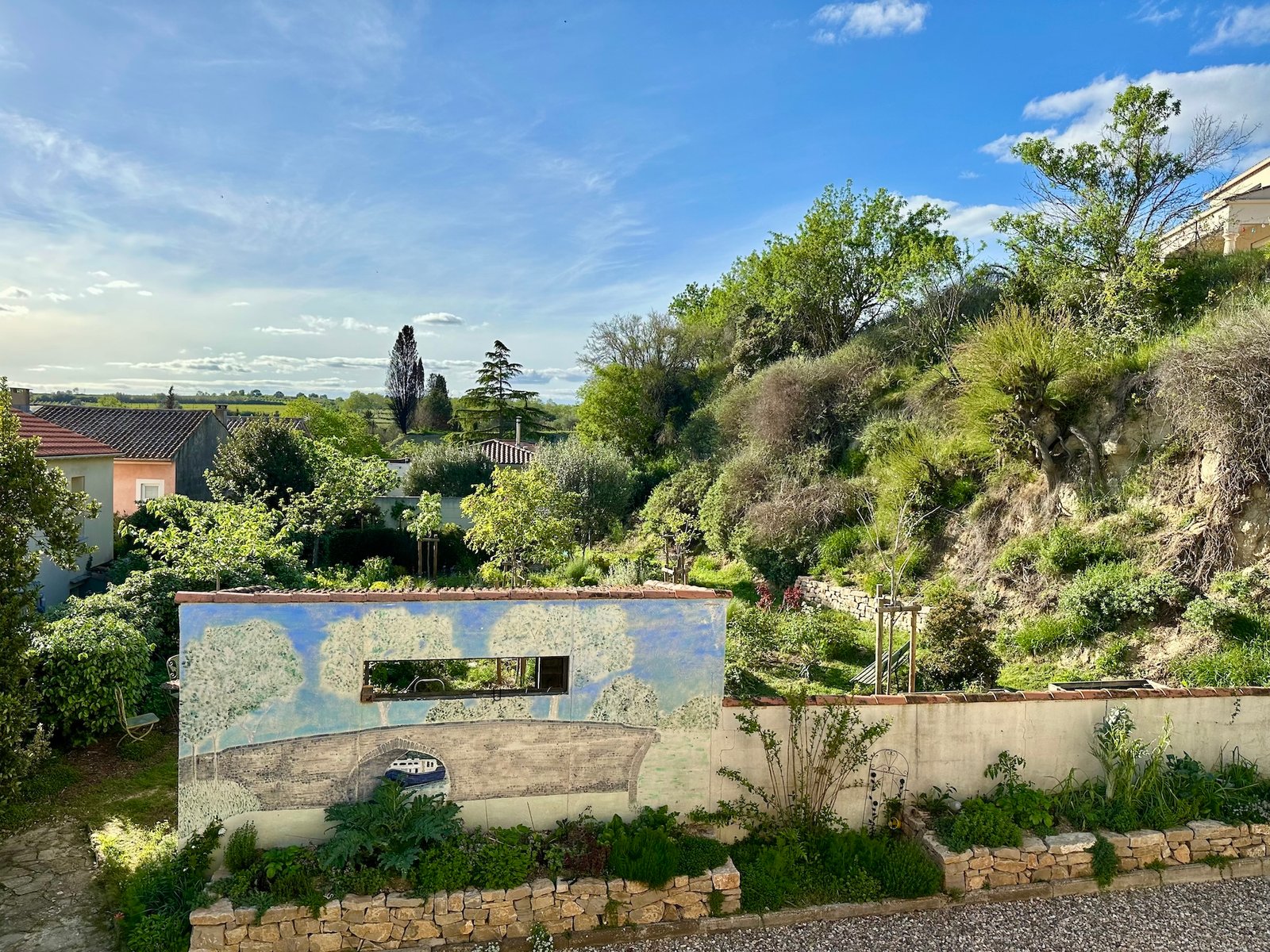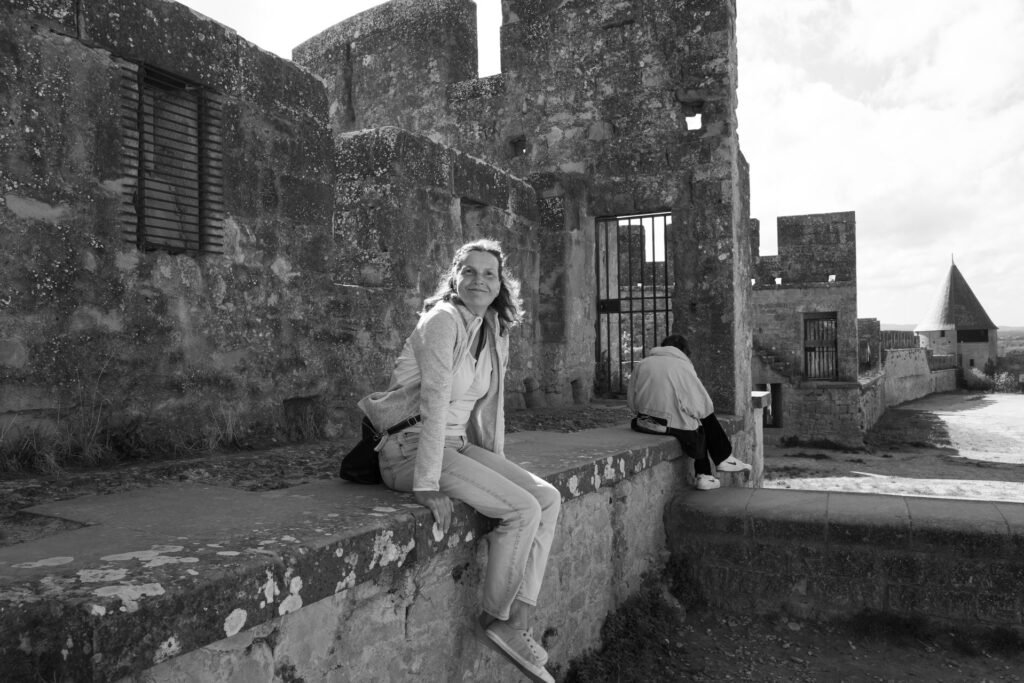
About the Garden
Climate
Our garden of about 1000 square meters is situated in a village in Hérault at a height of about 90 m.a.s.l.. It lies on the lower middle level of a terraced hillside. It is more or less enclosed by buildings, hedges, low walls, and a steep clay/rock slope on its northern side, so in the winter frost tends to hang around in the mornings. The garden lies directly in the way of the prevailing westerly wind and of the cold and strong Tramontane wind from the Northwest. Temperatures range from rare -3°C in the winter to increasingly frequent +35-40°C in the summer. Rains falls mostly during fall, winter and spring. In 2023-2024 we had about 203mm from October to March. The whole region has been beset by drought since 2022 and in 2024 water conservation crisis measures did not lift at all during the winter. We save as much water as we can from cooking or bathing and use it in the garden. We also plan to add rainwater recuperation measures when the gutters are renovated.
Soil and Layout
The garden used to be an orchard and/or vineyard 10-20 years back. Stunted old fruit trees and viciously spiny wildings, the descendants of former fruit trees, were still around when we moved in. The soil was poor and depleted clay, powdery soft on top, so you could dig it with a soup spoon. Rock hard clay about one or two spades deeper. Most trees had been taken out, and in the years before we moved in, the garden had been layouted as a large cottage garden with low boxwood hedges and low raised beds, separated by narrow paths. A youngish yew hedge in the middle had been planted, perhaps as a sort of windbreak.
First Experiences
Before moving here in 2022 I had already researched extensively on what plants would work here and started planting those – along with some hopeful experiments like rhubarb or columbines. I used the drought-resistance points given by Olivier Filippi on his website and planted only level 3 and higher. And as a first measure I continuously tried adding organic material to “nourish” the soil and improve its texture to store more moisture.
2023 was the first year to see what works and what doesn’t and the summer showed clearly:
1. Level 3 drought-resistance is not enough for a garden without watering here.
2. Planting shrubs or trees must be done in the fall so they can soak up all the moisture they can get during the winter. Large perennials can be planted if necessary until mid February – anything planted later needs too much watering to thrive.
2. The cottage garden layout did not work. It was simply too exposed to the sun and too large for effective watering and mulching. Tomatoes, beans, melons etc. dried up on the vine, despite mulching, watering and even shading.
First Changes 2023-2024
In 2023 we decided to turn the cottage garden into an informal park/forest garden by planting trees and shrubs and drough-tolerant plants, level 4-6 on Filippi’s scale. The latter is a bit of a balancing act with the local clay soil because most drought-resistant plants need a very draining soil – especially in winter, when it rains more often. I try to add gravel and coarse sand when planting those and continue to wait to see what works and what doesn’t. The plan for 2025/2026 is to have to water only vegetables and fruit and those as little as possible.
I let most weeds stand in the spring to keep the ground green and covered, and provide organic material later. I mow them after the poppies are finished blooming and only take out those weeds that are really nasty or invasive (thistles, dandelion, vetch, etc.). All open ground is covered in wood chips from our own shredder or when I can get them cheap at Lidl.
The vegetable garden has been moved closer to the house and into higher raised beds for ease of access and handling. The soil has been enriched and in 2024 I am experimenting with adding Zeolite when planting to help the soil around the roots store more water – in addition to dense planting, heavy mulching and maybe shading in summer. A “goutte à goutte”watering system will maybe be installed.
First Results – Spring 2024
Letting wild flowers grow freely among the shrubs planted in the fall has proven very effective. The garden that was more or less grey earth last spring is now lush and green and colorful. The soil is shaded by the plants and stays moist a lot longer.
The garden is definitely not maintenance-free because wild flowers have to be taken out when they start to overpower the purchased plants. But that’s mostly a matter of ripping them out to make space or to mow them down after they have bloomed and seeded. I want to keep a green ground cover for as long as possible to reduce soil temperature.
Where faded flowers are gone, the soil has been covered with bark mulch and/or chaff from the trimming of the big old tamarix tree.
In April and May this spring has been a lot wetter than last year so that I was able to extend planting season for smaller perennials into April.
Summer 2024
Early July:
Spring and early summer have been very kind. We’ve had 310 liters of rain per square meter and temperatures have been very reasonable between January and 6 July. That has been good for all the new trees and shrubs planted in fall and winter. On the one hand they got a very good start, on the other hand it will be easy to decide in the fall, what works and what simply doesn’t. Any plant who does not thrive after this incredibly easy spring and summer has no place here.
The ground became pretty bare in late June as the last faded wildflowers were taken out. Opening up vistas and allowing for plant-planning the gaps in autumn.
The wooden raised potager beds have had light shading (white winter fleece) in place since June and with tight planting, mulching, some buried waterbottles and adding zeolite in the planting holes I’ve been able to reduce deep watering to twice a week during the hottest days. The raised stone bed get shading only when temps go over 30 degrees.
Real heat from mid-July to end of August (28-38 degrees) then very reasonable temperatures.
Spring 2025
Almost all the trees and shrubs planted in the winter of 2023/2024 were doing fine. I lost only one Dorycnium hirsutum and another Stachys last year, and Perovskia just does not seem to want to grow here. After another application of horse manure in the winter the soil in the forest garden was rich and moist and I even saw the first earthworms. Rather long ones too! This will probably be the last big application of manure over the whole garden, future applications only where necessary.
In March and April the garden was lush and green with grasses and weeds. The walkway to the back needed to be “mowed” and the rest of the garden to be weeded at least weekly because everything was growing like crazy. So for the moment the garden in spring is still rather high-maintenance but the moist soil makes it pretty easy.
Heavy rains in May caused the sudden death of the Anisodontea – probably root rot.
Summer 2025
Three weeks of unseasonal and extreme heatwave in June. Lots of unseasonal rain and perfect summer temperatures in July and two weeks of Tramontane going into August. The plants mostly loved it and the garden looked a lot greener than normal for July. Another heatwave hit on August 10, with temperatures between 35 and 40+ degrees for a week.
The trees are growing, especially Robinia pseudoacacia Casque Rouge, which is already two to three times taller than the trees planted before or with it. It is suffering in westerly winds though and has lost a lot of leaves in the last long Tramontane event.
All Atriplex halimus shrubs along the steep embankment turned completely white in July, sucked dry by Monoxia obesula. Am currently looking for an alternative solution for soil retention – this is not made any easier by the fact that few professionals here heard about Monoxia obesula.
About Me
Born in 1962 I have lived and gardened in Washington State in the US, on the island of Kyushu in Southern Japan, in Germany and in Switzerland, before moving to Southern France in 2022 with my husband.
I do extensive research and am a Queen of Lists, but for the life of me I can’t plan out garden beds on graph paper. I plan roughly what needs to go where and I need lots of variety. There are so many lovely plants that will probably work here – why should I limit myself to only a few kinds?!
My experience shows that most things work out and that there’s always space for more plants – somewhere.

I couldn’t handle this garden without the help of my trusted sidekick and husband. He may not be that interested in all the fine detail but he is always ready to help when it comes to the heavy lifting, the shredding and cutting and carrying and spraying. Thank you love!